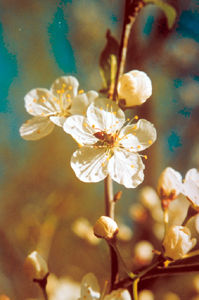Biological Oceanography is a branch of oceanography that studies living organisms (ie, the biota) in the sea in relation to their environments. The subject is interdisciplinary, requiring an understanding of the interactions among different marine organisms and of how the physical and chemical processes of the sea affect its living communities. The biota is generally taken to include 3 major groups of organisms: the plankton (pelagic plants or animals that float or drift almost passively in the water), the nekton (swimming pelagic animals) and the benthos (seafloor organisms). Biological oceanography is often viewed as a series of food chains in the sea.
Phytoplankton (planktonic plants), the primary producers, are consumed by the zooplankton (planktonic animals) or secondary producers. Plankton-eating fish (planktivores) form the third level of production and above these are the fish-eating fish which consume the planktivores. A typical example of such a food chain would consist of diatoms (phytoplankton) eaten by copepods (zooplankton) which are consumed by herring (planktivorous nekton) which in turn are eaten by dogfish (piscivorous nekton). Such a representation is convenient but it oversimplifies actual relationships, since there are many more interconnections than are implied.
The biological oceanography of the Pacific and Atlantic regions of Canada is governed by the subarctic water lying off both coasts. The subarctic communities of these water masses are characterized by a strong seasonal progression of plankton blooms, starting in spring and ending in fall. Production of larval and juvenile fishes is generally associated with the spring bloom; migration of adult fishes takes place in spring and fall. The release of benthic larvae is also generally associated with the spring phytoplankton bloom. The eventual settlement of some benthic organisms in relatively shallow areas is an important connection in the food chain for the commercially important fisheries found on the Grand Banks and other continental shelf areas. In the Arctic Ocean a single summer pulse of plankton occurs after the break-up of fast ice. This bloom, which may last for several months, supports an extensive food chain including zooplankton, fish, seals, polar bears and humans. However, the quantity of commercially available fish in the Arctic Ocean is very small compared to Canada's subarctic waters where plankton production is greater for a longer period of the year.
Recent developments in biological oceanography have included the remote sensing of biological events from space, and the remote sensing of deepwater communities from submersibles capable of descending to the greatest ocean depths (below 10 000 m). Satellite studies have been used to show the amount of plankton in different water masses, as determined by the chlorophyll concentration which influences the colour of the water. Deep submersible studies have recently shown the existence of biological communities which feed off energy-rich compounds that are given off at thermal vents in the seafloor (ie, deep-sea invertebrates). Other new techniques include the outfitting of commercial vessels for biological monitoring; the use of large plastic bag enclosures (over 1000 t) to study the ecology of the sea; and scuba-diving techniques allowing observation of delicate forms of plankton and direct experimentation with benthic communities.
In Canada, biological oceanographic studies are performed in the Atlantic, Pacific and Arctic oceans by university departments of oceanography and government oceanographic institutes, and at a large number of federal fisheries stations. Consulting companies have taken part in biological oceanographic studies in connection with environmental planning. This last area is of growing importance since the possible dire effects of man-made pollution on the oceans have become recognized in certain limited environments, eg, when oil spills occur in coastal water or when urban or industrial sewage systems discharge into the sea (see Water Treatment). The biological oceanography of these altered environments differs with each location.

 Share on Facebook
Share on Facebook Share on X
Share on X Share by Email
Share by Email Share on Google Classroom
Share on Google Classroom


